“Most people assume that [trained AI] models can at most be protected by some combination of trade secret and copyright protection. Although those can be valuable forms of protection, it’s worth considering patent protection as well.”
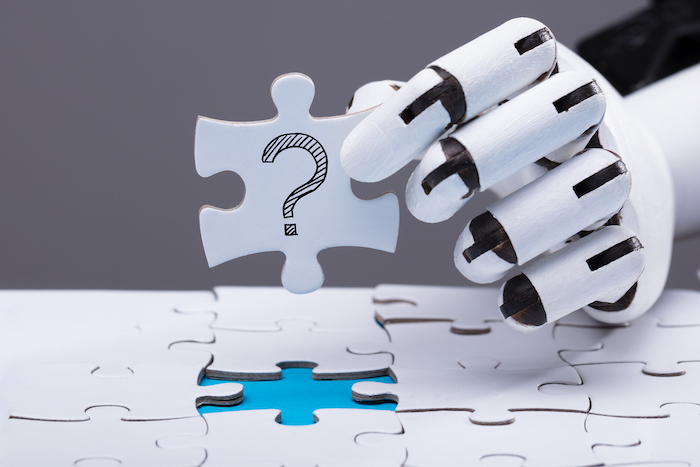 Artificial Intelligence (AI) stands at the forefront of innovation, transforming industries and shaping the future of global economies. Although AI innovators understand the value of intellectual property (IP) protection for their innovations, they often don’t know how to secure the right kind of IP protection for their innovations.
Artificial Intelligence (AI) stands at the forefront of innovation, transforming industries and shaping the future of global economies. Although AI innovators understand the value of intellectual property (IP) protection for their innovations, they often don’t know how to secure the right kind of IP protection for their innovations.
Employing a process for systematically mining AI innovations to create a map of those innovations is one option for identifying the most suitable form(s) of IP protection to obtain, based on the innovation and the business model within which that innovation will be commercially deployed. In my experience working with innovative AI companies, I’ve found that this approach enables the resulting IP to be used as a strategic tool to fulfill critical business objectives, such as attracting investment, increasing revenue, securing successful company exits through acquisitions or IPOs, and even attracting and retaining top talent. This enables IP to be used in ways that go far beyond the traditional passive and reactive use of IP merely as a defense against possible future infringement.
AI IP Mapping: An Introduction
Imagine you’ve developed some new AI-related technology, such as a new method for training a model that can identify malignant tumors, or a way of applying that model to data more efficiently than ever before. The mapping process that I will now describe involves taking a deep dive into your technology to identify what makes it unique.
Think of it as creating a detailed inventory of your AI innovation’s special features, using a systematic approach that’s designed not to leave any stones unturned, and to identify both individual components and their interactions with each other.
When I describe it that way, Mapping might sound like a simple and obvious thing to do, but I see a lot of IP, especially patents, that are created without first developing a map. This is very easy to do if your patent strategy is driven by invention disclosures.
What does that mean? It means that the inventors in a company come up with a brilliant new idea and write a description of it in an invention disclosure document, which gets provided to the company’s patent attorney. Some decision is made about whether or not to patent the invention. If the company decides to patent the invention, the patent attorney writes a patent application based on the invention disclosure.
This is what I mean by a “disclosure driven” patent strategy.
Now you might ask, “What’s wrong with that? Don’t patents have to cover new inventions, and aren’t inventors in the best position to know when they’ve invented something that might be patentable?”
The answer is both “yes” and “no.” Of course inventors and invention disclosures play a critical role in the patenting process, and some excellent patents can result from the disclosure-driven process I’ve just described. But that process also has some serious drawbacks, which are easiest to understand by pointing out the problems that can result from it.
Imagine instead that we use an IP strategy that’s driven by the goals of the business. Whatever the goals of a particular business are, if you don’t identify those goals clearly up front, then you can easily fail to seek and obtain IP protection for innovations that are critical for achieving those business goals. As just one example of that, if your business’s goal is to become attractive as an acquisition target for a specific acquirer, and you don’t keep that in mind when deciding which of your inventions to patent, you might inadvertently forgo seeking patent protection for an invention that’s a relatively incremental improvement over existing technology, but which could be extremely valuable to your ideal acquirer. In other words, if you solely use the degree of technological novelty as the basis for your patenting decisions, rather than taking your business goals into account, you can easily target your patenting efforts in the wrong place.
Similarly, if you focus solely on patenting whatever is most technologically innovative and therefore easiest to patent, you might obtain some quick and easy patents, but those patents might not help you to protect or promote your core business. This can result in a patent portfolio that looks impressive on paper, but has limited value to the business.
Two additional problems that result from the failure to create a map are creating IP protection that is too broad and creating IP protection that is too narrow:
- If a patent is broader than you need it to be to achieve your business goals, you might increase the difficulty and cost of obtaining the patent in the first place, and you might make it easier and less expensive for your competitors to invalidate the patent.
- Overly-narrow patents are less likely to be infringed, and therefore are difficult or impossible to enforce. In the context of AI, this might result from including too many components in a single patent claim, which enables competitors who only implement one of those components to avoid infringement. This is a particular risk in the context of AI, where innovations have many components and can be implemented in many forms and within a wide variety of business models.
As we walk through the Mapping process, it should become clear how Mapping helps to create a foundation that minimizes the risks of all of the problems I’ve just described.
Mapping With the MIND AI Framework
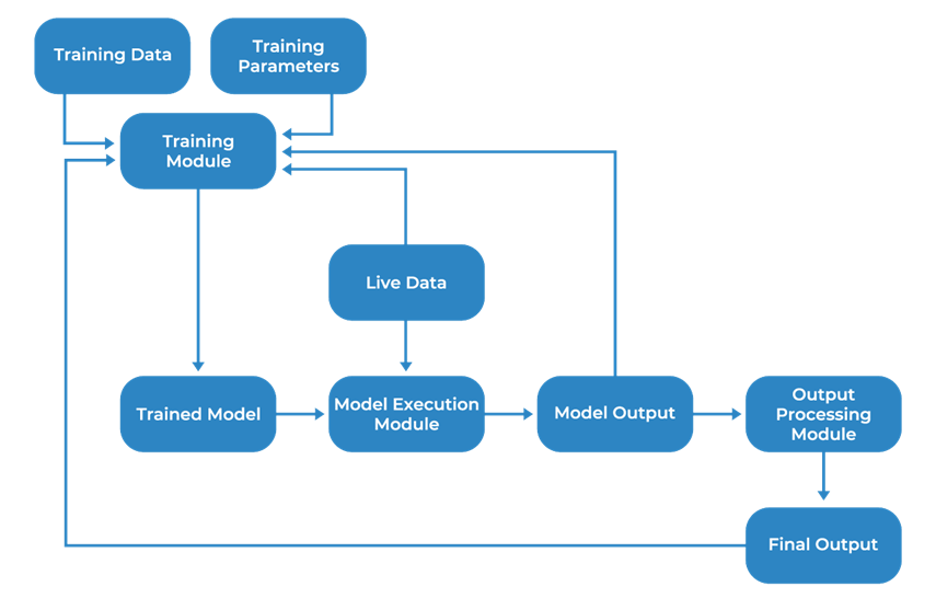
I’ll describe the mapping process by reference to what I call the MIND AI Framework, shown in the diagram above. MIND is a four-step process I coined and describe in detail in my upcoming book (see author bio for details). Mapping is the first of the four steps of the MIND process.
The MIND AI Framework includes the basic components of typical machine learning systems and acts as a guide in the mapping process. (Although there are many types of AI other than machine learning, the description herein can easily be adapted to other kinds of AI.)
As we walk through each component of the MIND AI Framework, you might want to apply it to one of your own AI innovations and ask yourself:
- Which components from this framework does your AI system contain?
- How does each component differ from existing technologies?
- How does each component enhance the AI system’s performance, efficiency, or accuracy compared to competitors?
- What competitive advantages does each component confer, taking into account the forms it will take in your commercial offerings?
Model Training
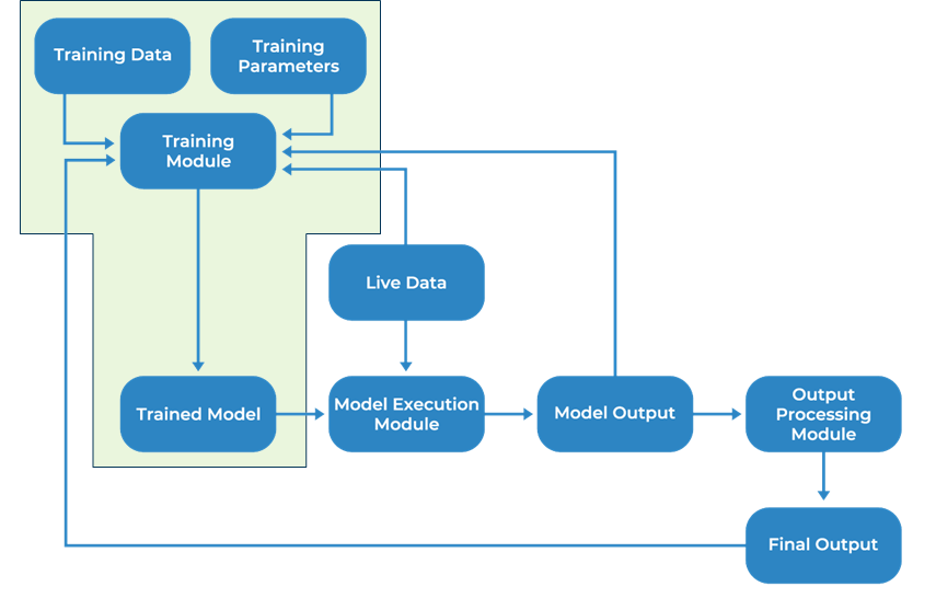
Let’s start first with the components of the framework that relate to training, namely, the Training Module, which trains a model (shown as the “Trained Model”) based on Training Data and Training Parameters.
In my experience obtaining IP protection for AI systems, the heart of the novelty and competitive advantage conveyed by such systems very often lies in the Training Module and the Training Data and Training Parameters that it uses. Even when a client’s description of their invention focuses on the benefits of some new model they’ve created, usually they’ve created that model using some new training process. As a result, very careful attention should be paid to identifying any innovative features and competitive advantages conveyed by the training-related components of any AI system you’re analyzing.
This is also a good time to point out the importance of evaluating trade secret protection vs. patent protection for different aspects of an AI system. For example, you might want to keep your training data or your training parameters as trade secrets but patent your training module. Whether you can obtain that dual benefit, however, will depend on a variety of factors. For example, you might not be able to patent the training module and keep the training data and training parameters as trade secrets if someone needs to know what your training data and training parameters are in order to make productive uses of your training module, because in that case you’ll need to disclose the training data and training parameters in your patent application.
It’s worth carefully considering whether the process performed by your training module is patentable, because if you can obtain a patent on that process, the patent would be infringed by anyone who uses the same process to train a model. This could be quite a powerful patent, and it addresses the problem I mentioned earlier of obtaining patent protection that is too narrow, by separating patent protection for the training process from other aspects of the AI system, such as the process of executing the trained model.
The Trained Model
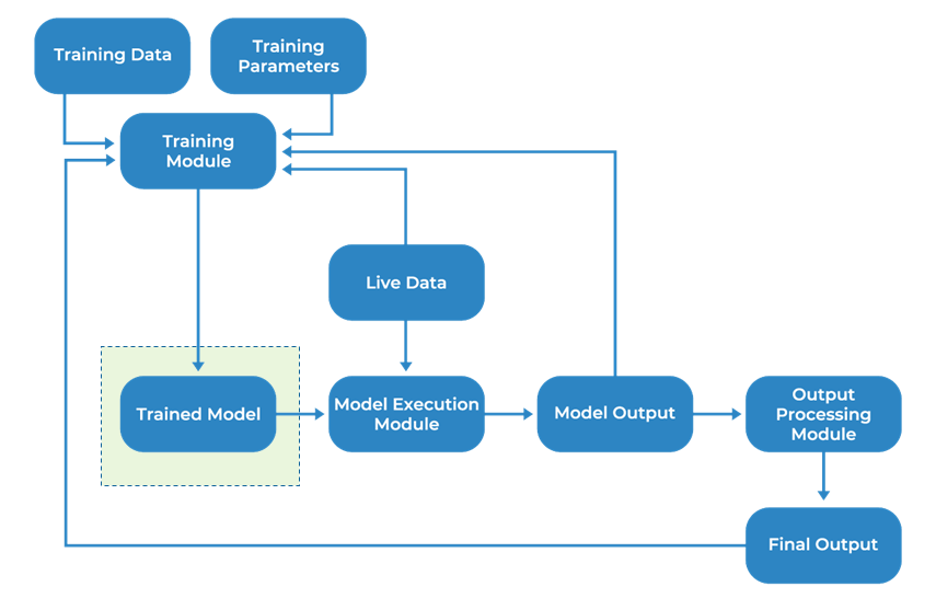
The resulting Trained Model is often what gets the most attention, and everyone knows about widely-used models like GPT, Gemini, Claude, and Mistral. The Trained Model represents the culmination of the training process executed by the Training Module, embodying the practical application and intelligence of the AI system.
Most people assume that such models can at most be protected by some combination of trade secret and copyright protection. Although those can be valuable forms of protection, it’s worth considering patent protection as well.
Patenting a trained model might not occur to you immediately, but if the model is new, useful, and nonobvious, then why not at least consider patenting it? Data structures are patentable subject matter under U.S. law but may not be under the law of all countries.
This is particularly true if you, or your competitors, would find commercial value in selling or licensing trained models, because if a competitor sells a trained model and you have a patent claim covering that model, then each sale is an act of infringement. This could net you much larger damages than a method for training the model, which might only be performed once to generate a model that is sold and used many times.
Live Data

Next is the Live Data, which is the data that is input to the Trained Model during its real-world application, such as user behavior data in recommendation systems or Internet traffic data in a network security application.
In some cases, it isn’t possible or worthwhile to obtain IP protection for the Live Data. In other cases, the most suitable forms of protection for the Live Data are copyright, trade secret, or some combination of both.
There are, however, scenarios in which it might be possible to patent the live data, or at least to obtain patents that make use of the Live Data. I won’t go into that in detail here, because a previous article of mine on IPWatchdog covered that topic.
Model Execution
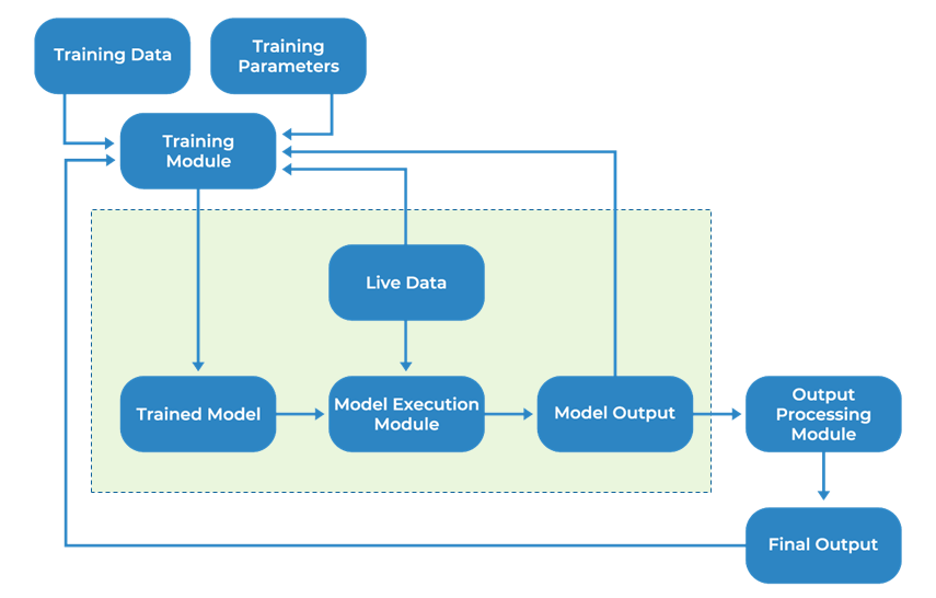
The rubber meets the road in the next component of the MIND AI Framework: the Model Execution Module, which applies the Trained Model to the Live Data to generate output, which I refer to as the Model Output. A well-designed model execution module can produce significantly better results, or the same results more efficiently, than an inferior model execution module. So, it’s important to examine the model execution module to determine whether there is anything innovative about it that confers a competitive advantage.
In my experience obtaining IP protection for AI systems, I’ve been seeing significant effort being put into producing improved Model Execution Modules, whether to increase the speed of execution, to improve the quality of the Model Output, or to expand the ability to handle specific kinds of Live Data. The benefits that can result from any such improvements to the Model Execution Module make it a prime candidate for IP protection, especially patent protection.
Model Output
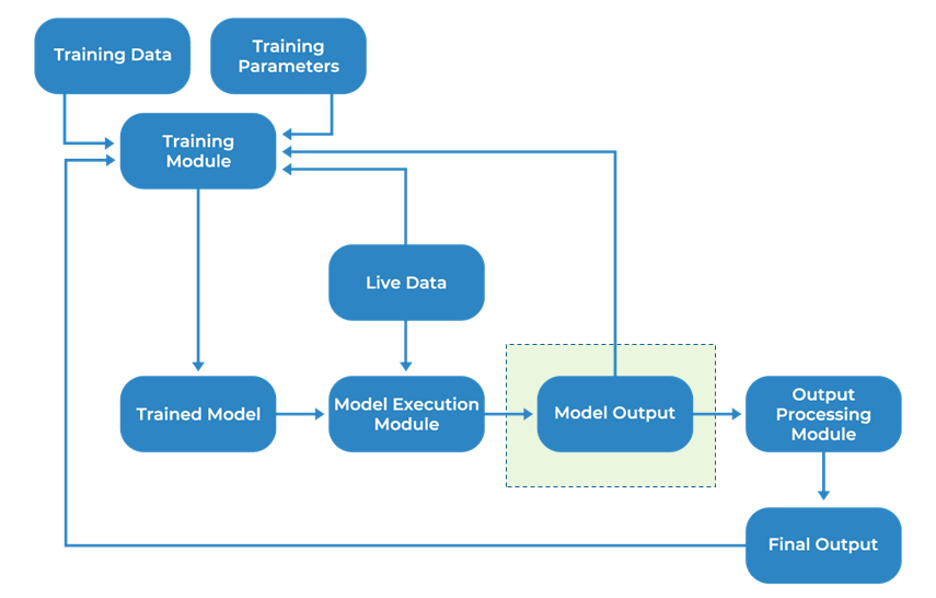
The next component is the Model Output, which results from applying the Trained Model to the Live Data. The Model Output can take a wide variety of forms and serve many different purposes. For example, in predictive AI systems, the Model Output might predict whether a tumor is malignant, or a network access attempt is malicious. In a generative AI system, the Model Output might be text or an image that is generated based on a prompt.
It would be easy to think of the Model Output solely as data, protectable only using copyright or trade secret protection, and therefore not within the scope of patent protection. Although this might be true for some kinds of Model Output, keep in mind that, especially now in the age of generative AI, the Model Output might represent a specification for a product, the chemical structure of a drug, or software code that describes an algorithm. If any of these products or processes represented by the Model Output are new, useful, and nonobvious, then they might be patentable. In fact, the Model Output is an example of the “AI-assisted inventions” that are the subject of the USPTO’s recently-published inventorship guidance.
Refining the Output and the Model
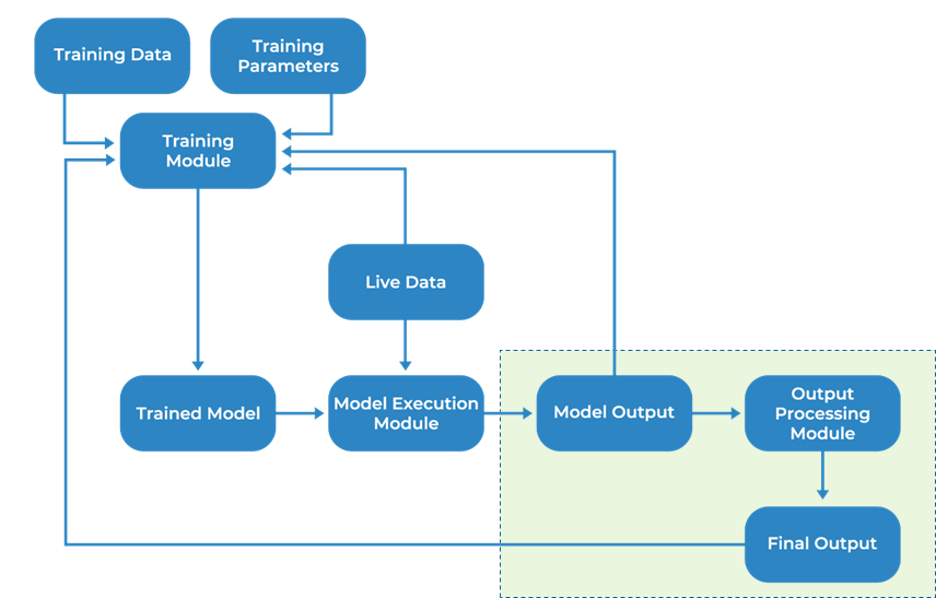
Although it might seem that the Model Output takes us to the end of the line, I’ve included three additional components in the MIND AI Framework to reflect the ways in which real-world AI systems tend to evolve even after they have produced the initial Model Output.
First is the Output Processing Module, which transforms the initial Model Output into a form that is refined, usable, and suitable for commercial use. It is here that the raw output of the AI system is polished, ensuring it meets the necessary quality standards, ethical considerations, and legal requirements for real-world application. Consider an AI system for drug discovery which generates a thousand potential drug designs, in which case the Output Processing Module might prioritize and filter those outputs to produce three candidate outputs that are then synthesized and tested in a lab in the real world.
Then there’s the processed output itself, which is shown in the diagram as the Final Output. This is the polished, market-ready result that emerges from the Output Processing Module, representing the culmination of the AI system in its most usable and valuable form.
Finally, I’ve added a new component to the MIND AI Framework in the diagram below: the Model Refinement Module, which reflects that the Trained Model may itself evolve over time to ensure its continued relevance and effectiveness in the face of new data and changing needs. In an environment where data patterns, user preferences, and operational conditions are constantly shifting, this module ensures that the AI system remains up-to-date and accurate. For example, antivirus software might engage in automatic retraining of its models based on malicious software that it encounters in the wild.
For each of these components that refine the Model Output or the Trained Model itself, you can apply all of the considerations that I previously described for evaluating the best form(s) of IP protection to seek.
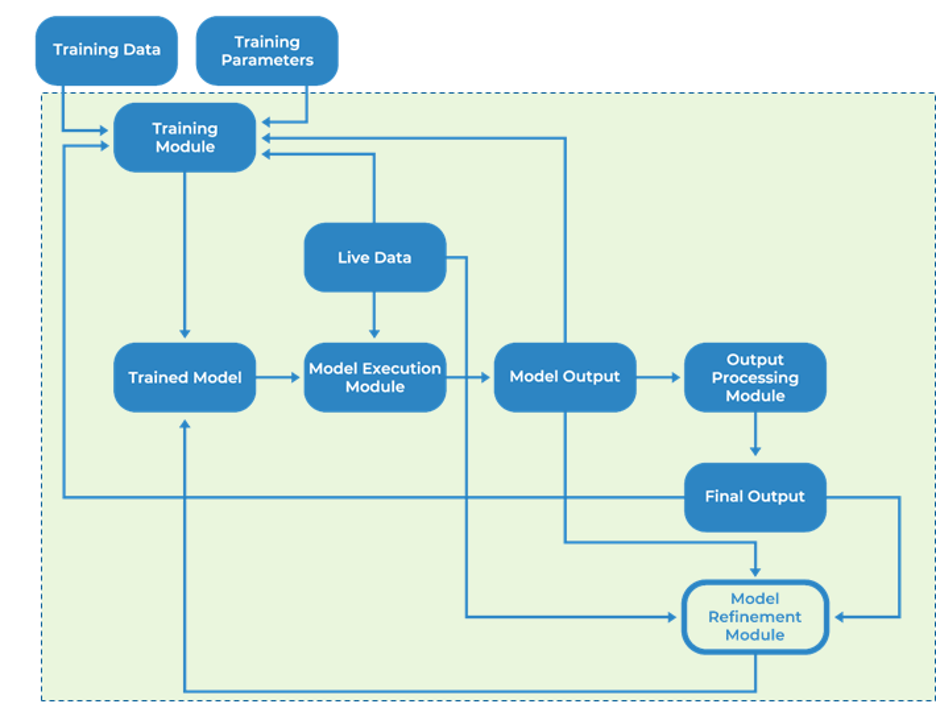
Key Lessons from AI IP Mapping
Traditional approaches to securing IP, such as hastily jumping straight to pursuing patent protection based on an invention disclosure, can both overlook better-suited strategies and lead to suboptimal outcomes, such as commercially irrelevant patents, failure to patent business-critical inventions, overlooked trade secrets, and improperly scoped claims.
The Mapping process offers a structured, strategic approach that is designed to lay the foundation for giving comprehensive consideration to all available forms of IP protection for new AI technologies. This initial, crucial step minimizes the risk of overlooked opportunities and misalignments with business objectives by breaking down an AI system into its constituent components and processes, and systematically identifying and analyzing each of those components (and their combinations) relative to available forms of IP.
Although the Mapping process is only an initial step and does not yet take into account a business’s strategic goals or apply those goals to pursue, secure, and apply appropriate forms of IP protection in light of those goals, it sets the stage for doing so. In future articles, I’ll explain ways to use the map that results from the AI IP Mapping process to promote business success.
Image Source: Deposit Photos
Author: AndreyPopov
Image ID: 190333802

![[IPWatchdog Logo]](https://ipwatchdog.com/wp-content/themes/IPWatchdog%20-%202023/assets/images/temp/logo-small@2x.png)

![[Advertisement]](https://ipwatchdog.com/wp-content/uploads/2024/04/UnitedLex-May-2-2024-sidebar-700x500-1.jpg)
![[Advertisement]](https://ipwatchdog.com/wp-content/uploads/2024/04/Artificial-Intelligence-2024-REPLAY-sidebar-700x500-corrected.jpg)
![[Advertisement]](https://ipwatchdog.com/wp-content/uploads/2024/04/Patent-Litigation-Masters-2024-sidebar-700x500-1.jpg)

![[Advertisement]](https://ipwatchdog.com/wp-content/uploads/2021/12/WEBINAR-336-x-280-px.png)
![[Advertisement]](https://ipwatchdog.com/wp-content/uploads/2021/12/2021-Patent-Practice-on-Demand-recorded-Feb-2021-336-x-280.jpg)
![[Advertisement]](https://ipwatchdog.com/wp-content/uploads/2021/12/Ad-4-The-Invent-Patent-System™.png)






Join the Discussion
2 comments so far. Add my comment.
Mike Cicero
March 14, 2024 10:50 amThank you for sharing this informative piece, Mr. Plotkin. I hope your upcoming book meets with a high degree of success for you.
Model 101
March 13, 2024 01:21 pmRobert…great article however 101 will kill every ai patent. Generic computer and data manipulation are still in 101 as killers.
Your diagrams will be used as prior art references.
These are the sad realities.
Oh well!
Add Comment